Paint the Roses is a clever deduction puzzle with dire consequences for mistakes: don’t lose your head!
What Is Paint the Roses?
Paint the Roses is a cooperative deduction game for 2 to 5 players, ages 11 and up, and takes about 45–60 minutes to play. It’s currently seeking funding on Kickstarter, with a pledge level of $30 for a copy of the game, or $60 for the deluxe edition that includes the Escape the Castle expansion. While I did play Paint the Roses with my 8-year-old, some of the deduction elements can be pretty tricky to figure out, so it is a bigger challenge with younger players; that said, it’s also a great way to play with logic with your kids.
Paint the Roses was designed by Ben Goldman and published by NorthStar Games, with illustrations by Jacqui Davis.
New to Kickstarter? Check out our crowdfunding primer.

Paint the Roses Components
Note: My review is based on a pre-production copy, though unlike most Kickstarter prototypes I get, this one seems pretty indistinguishable from the real deal, and is likely to be very close (if not exactly the same) as the final product. I was sent the Deluxe edition, which includes some upgraded components as well as the expansion.
Here’s what comes in the base game:
- Game board
- 20 Easy Whim cards
- 40 Medium Whim cards
- 72 Hard Whim cards
- Cloth bag
- Greenhouse board
- 4 Rose tokens
- Gardener miniature
- Queen miniature
- White Rabbit miniature
- 32 Shrub tiles (including 8 starting tiles)
- 30 Clue tokens (6 each in 5 player colors)
- 3 Notepads (Placement Order, Medium, and Hard)
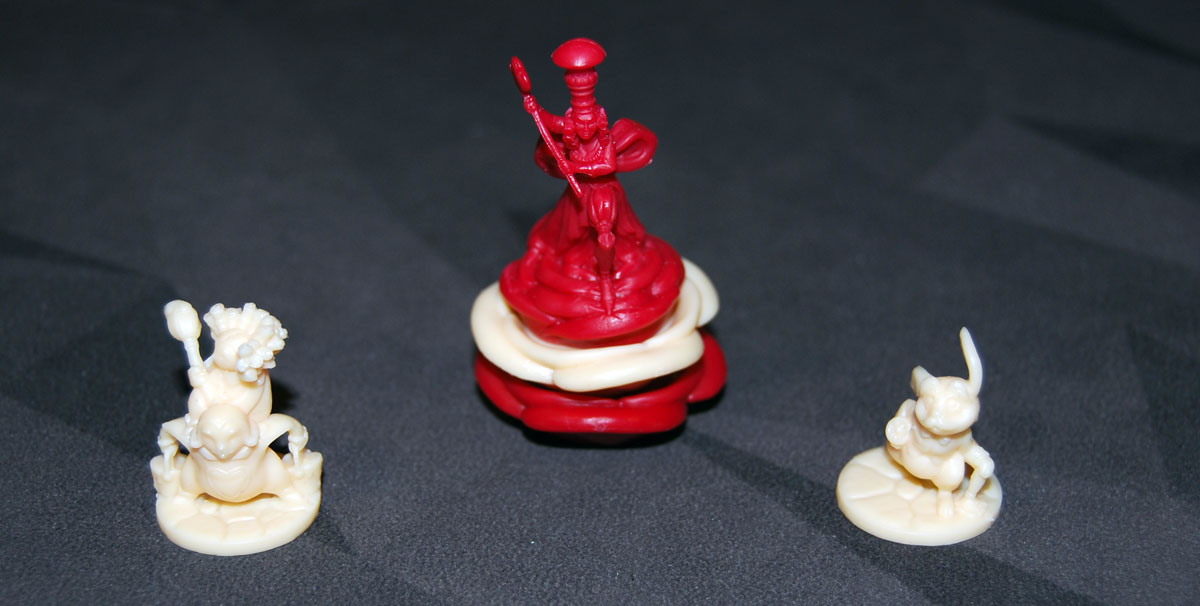
The miniatures are based on Jacqui Davis’ illustrations, and have some lovely details (though I’m sure they would look better painted, or at least a wash to highlight those details). The gardeners pawn features two hapless figures with paint buckets and a big brush. The Queen looks vicious, wielding an axe as she chases down the gardeners, and her figurine is designed to attach to the flower tokens, so that you can stack them up. And the White Rabbit, of course, is checking his pocket watch on his way to an important date.
The illustrations are charming and full of personality, and Davis has put her own spin on these iconic characters—they’re quite different from the Disney versions we’re all familiar with (Alice in pigtails? Shocking!) but still recognizable and fun. Well, except I have to admit that the human-like nose on the White Rabbit may have been a bit too far. Jacqui, I’ll let that one slide this time, but bunnies need cute bunny noses. That’s just how it is.
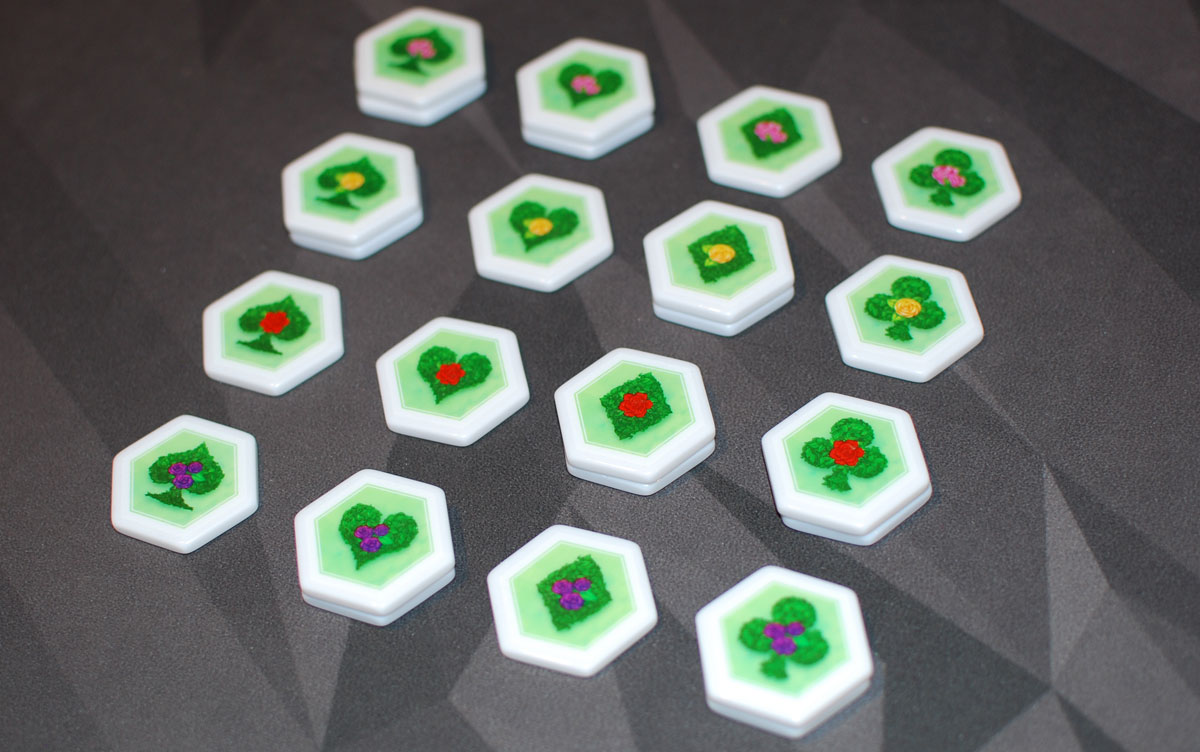
Each shrub tile features some greenery cut into the shape of a card suit, along with some roses in one of four colors. Every possible combination is represented twice, though 8 of them are starting tiles so they won’t go into the bag with the rest. The starting tiles are helpfully marked with a dark green border, and a different colored back. The deluxe version uses acrylic tiles instead of cardboard, and they’re really nice to handle, with a satisfying weight to them.
The game includes three notepads to help you make notes as you play the game. My concern is that you may easily run out of these, particularly the “medium” sheets. Paint the Roses doesn’t use one sheet per player—it’s actually one sheet per whim card, and in any given game you might be going through 15 cards. While not every card will require a sheet to make notes (in some cases you can guess a card right away and you won’t need to write anything down), it may take some practice before you get to the point that you feel confident enough not to jot things down. For this review, I often used the same sheet multiple times, erasing it and reusing it, but I’m planning to laminate a set of 5 so that I can just use dry erase markers instead. I think it would have been nice to have these be dry erase cards instead.
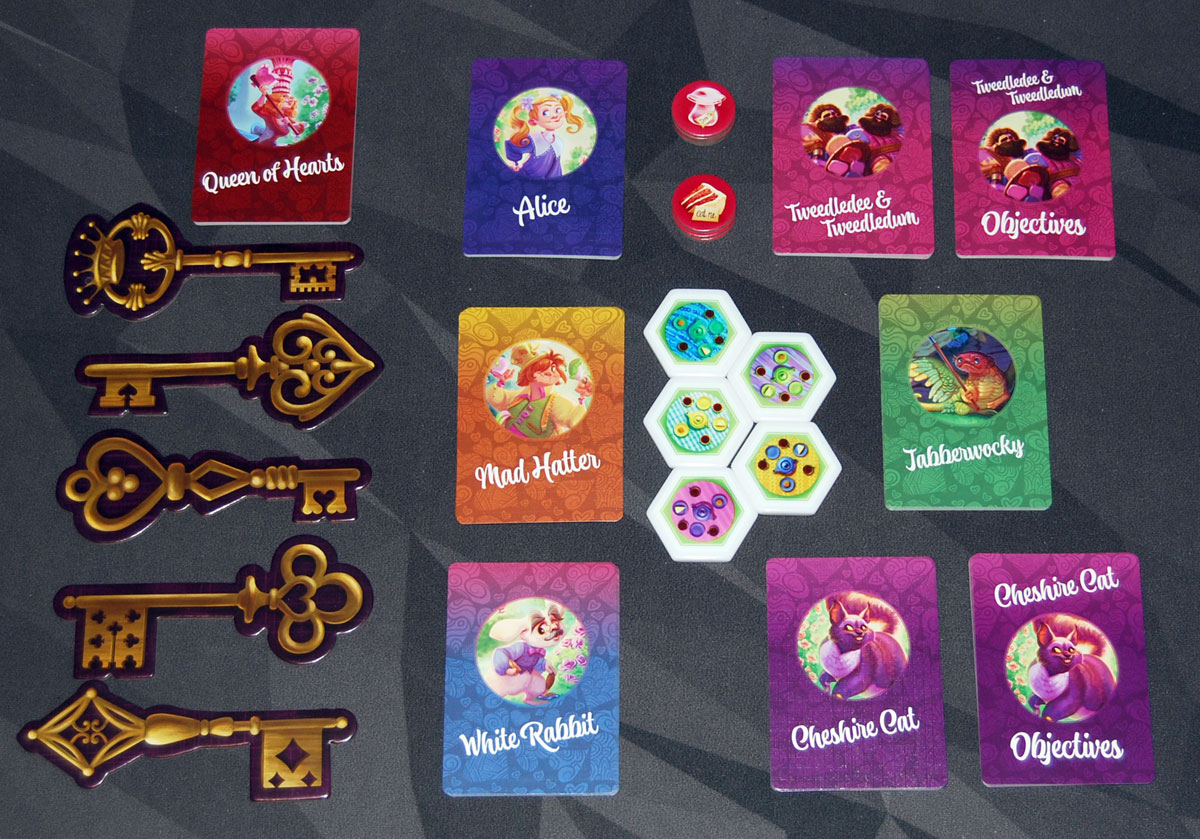
The Escape the Castle expansion, included in the Deluxe edition or available for a $25 additional pledge, contains the following:
- 5 Castle Key tokens
- 10 Queen of Hearts cards
- 9 Alice cards
- 9 Mad Hatter cards
- 10 White Rabbit cards
- 18 Tweedledee and Tweedledum cards
- 8 Jabberwocky cards
- 20 Cheshire Cat cards
- 4 Drink Me tokens
- 3 Eat Me tokens
- 5 Tea Party tiles

Aside from including the expansion, the Deluxe edition also includes a few component quality upgrades. The main board is dual-layered, so the hexagonal shrub tiles don’t slide around on the board, and the shrub tiles are acrylic instead of cardboard. Also, you get the GameTrayz organizer to keep everything in its place. There’s a bottom tray that holds the cards, notepads, and most of the expansion material, and then the double-heart-shaped top tray holds the miniatures, cubes, and shrub tiles, with a lid that keeps things from shifting around. (My only complaint about the tray is the area for the expansion cards, which are splayed out—if you take the cards out of their plastic wrappers, they still shift around, which makes it harder to pull out a specific set.)
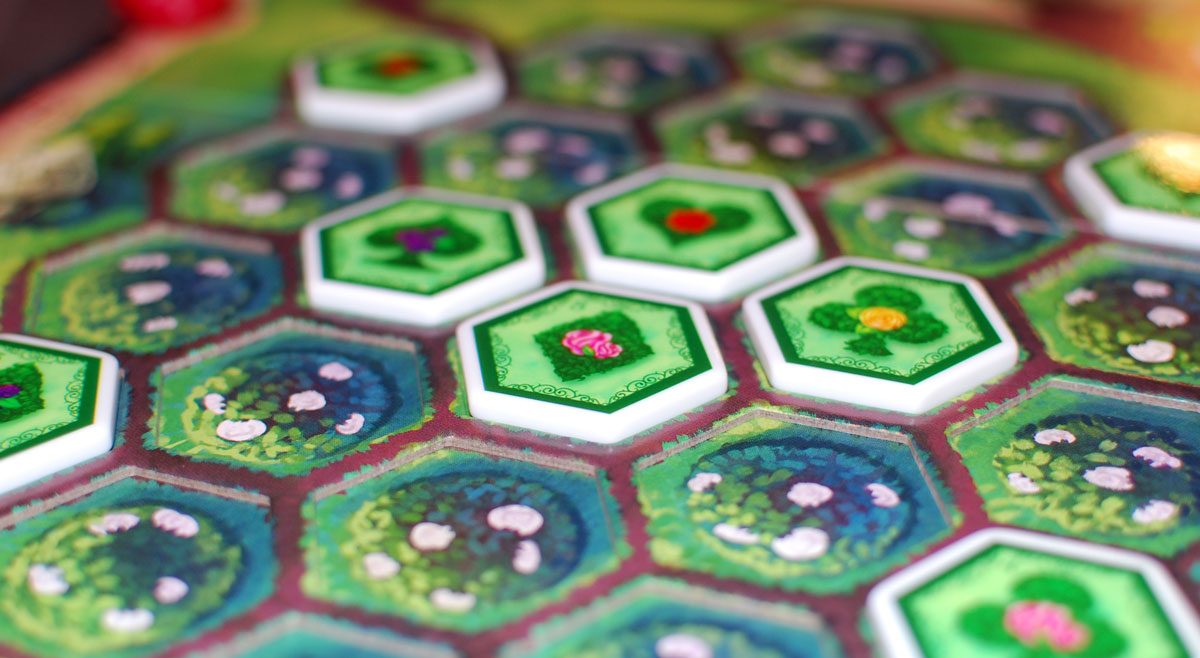
The Deluxe edition is definitely a premium set, for those who love upgraded bits in their games, but the gameplay itself is the same in the regular edition.
How to Play Paint the Roses
You can download a copy of the rulebook here. It is also available to try out on Tabletop Simulator and Tabletopia.
The Goal
The goal of the game is to fill in the garden while avoiding the Queen’s axe—you must figure out your teammates’ whim cards based on the clues they give. There’s also a scoring element, so you can record your progress even if you do lose your head.
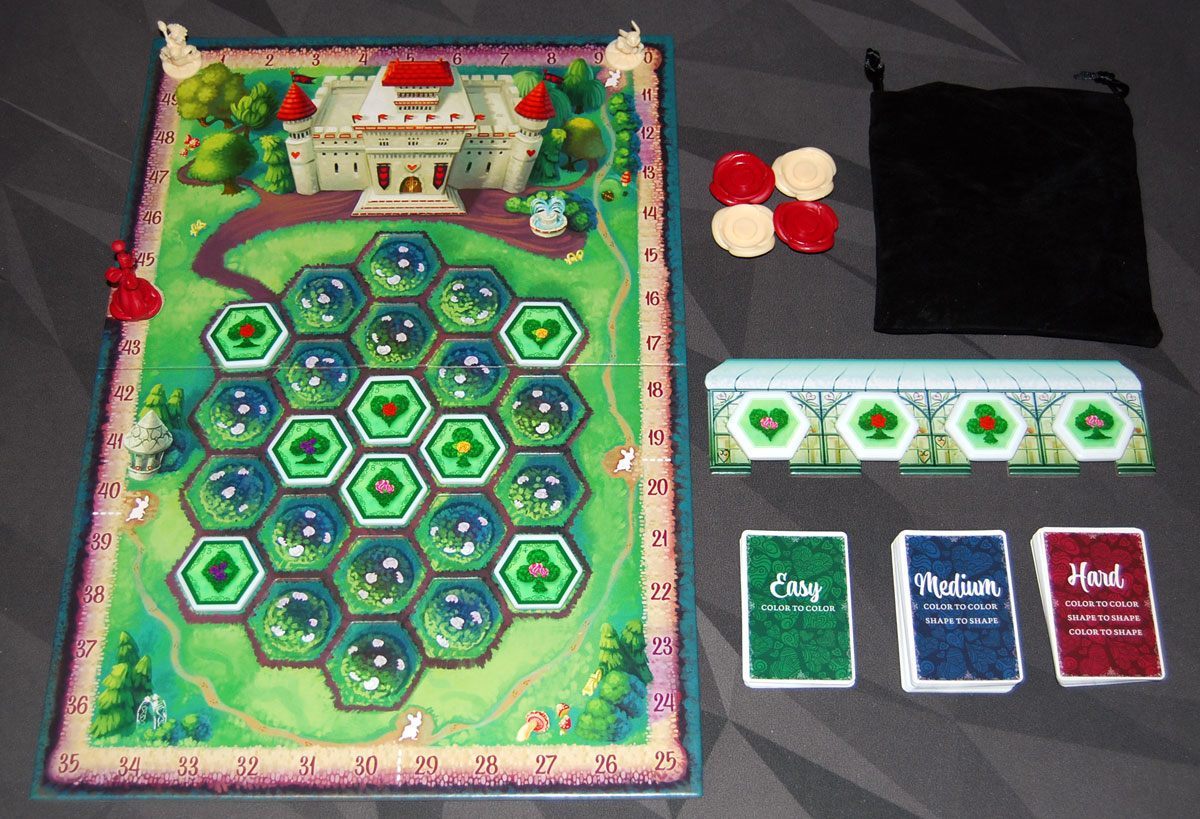
Setup
The main board is set up with the 8 starting shrubs placed in their marked spaces. Place the rest of the shrubs in the bag, mix them up, and draw 4 to place in the greenhouse.
The Queen starts on space 44 (which is marked with a heart), the gardeners start at 0, and the White Rabbit is placed on the first icon next to the scoring track, between 9 and 10. Set the rose tokens nearby.

Shuffle the three whim decks—easy, medium, and hard—and set them nearby. Each player should draw a whim card, keeping it secret from the other players. Only one player may have an easy card at any given time.
Each whim card shows a pair of hexes, with a match that the Queen currently likes. Easy cards only feature color-to-color matches; medium cards include both color-to-color and shape-to-shape; hard cards also throw in color-to-shape matches.
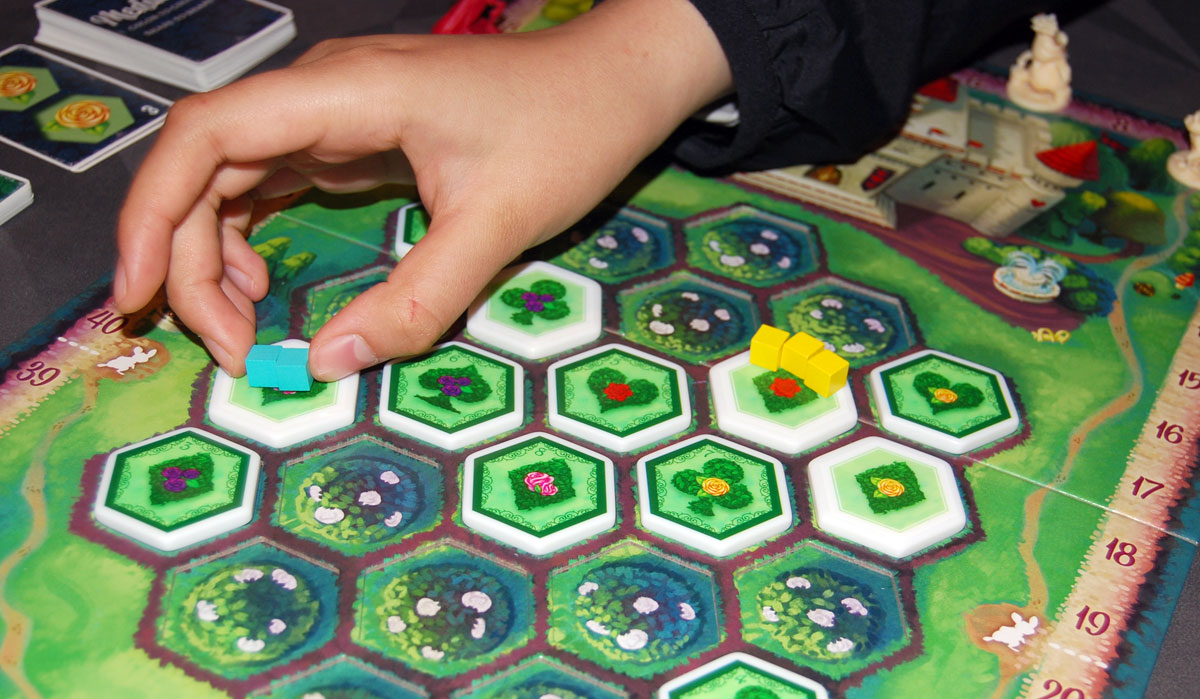
Gameplay
On your turn, you place a tile from the greenhouse into the garden, adjacent to at least one other shrub tile. Then, every player compares the new tile to their own whim card. For each matching pair that the new tile creates with its neighbor, the player places a clue token on the new tile. For instance, in the photo above the new tile is a pink heart tile, and the blue player is adding two cubes because their card shows a pink-to-purple match and there are two adjacent purple shrubs.

Players then use the notepads to take notes about their teammate’s clues. You can use Xs to mark out combinations that you’ve eliminated, or circles to indicate possible solutions based on the clue tokens. (Note that players are not supposed to make any notes about their own whim cards, nor are you allowed to talk about your whim card or give additional information about choosing tiles from the greenhouse, where they’re placed, etc.)
After everyone has placed clue cubes and notes are done, the group must guess at least one whim card. If correct, the player discards the whim card, and moves the gardener along the track according to the number on the whim card. You may continue to guess other player’s cards if desired—though it’s usually not recommended. Every time the gardener moves past the White Rabbit, you add a flower to the Queen, and then move the rabbit to its next space. If incorrect, the guessing phase ends immediately.
Then the Queen advances: her pace is indicated by the number of roses she’s standing on (including the one on her base). If you made an incorrect guess, the Queen advances double instead.
Then everyone who doesn’t have a whim card draws a new one, the greenhouse is refilled, and it’s the next player’s turn.
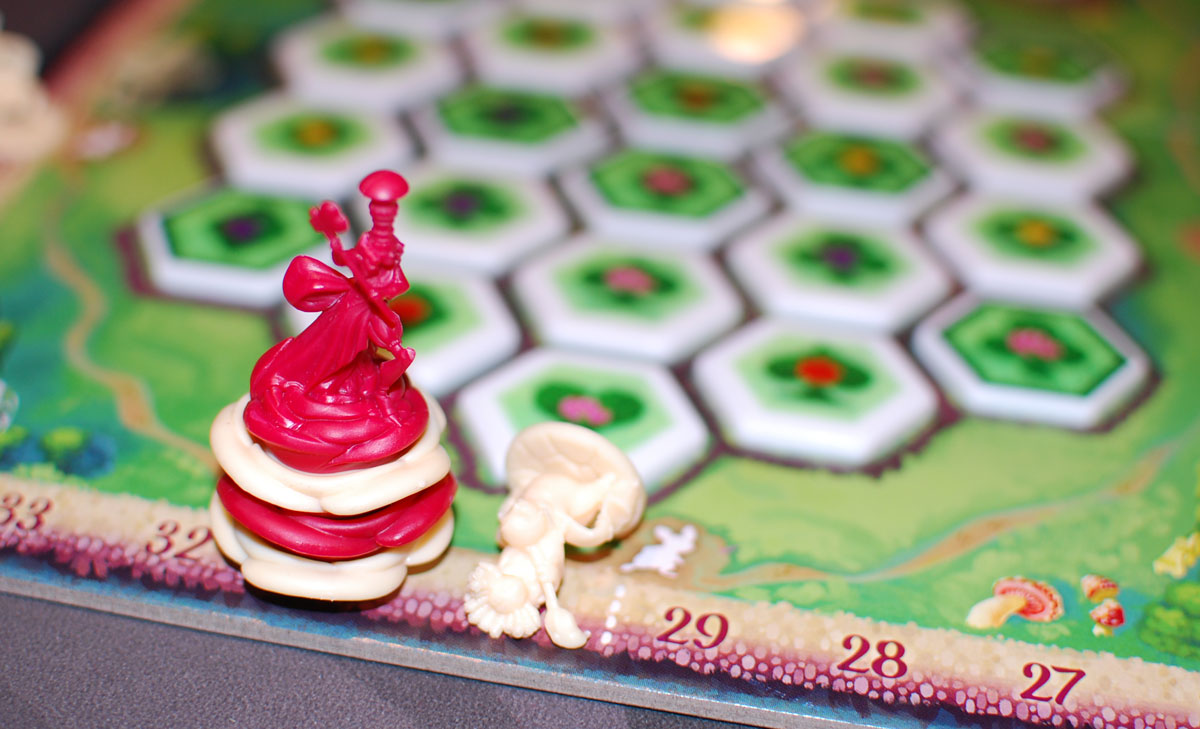
Game End
If the Queen ever catches up to the gardeners, the game ends immediately and you lose.
Otherwise, if you have finished advancing the Queen and there are no more open spaces in the garden, you win!
Your score is where the gardeners ended the game, but you subtract 10 points if you lost your heads.
Escape the Castle expansion
I didn’t get a chance to dig into the Escape the Castle expansion, but here’s a quick overview on how it works. Your goal, aside from filling the garden, is to collect the 5 keys in order to escape. Each game will use the Queen cards, and one set of helper cards.
There’s always one Queen card in play, and one Helper card in play. Each time the White Rabbit moves, you draw one of each and decide as a group which to keep.
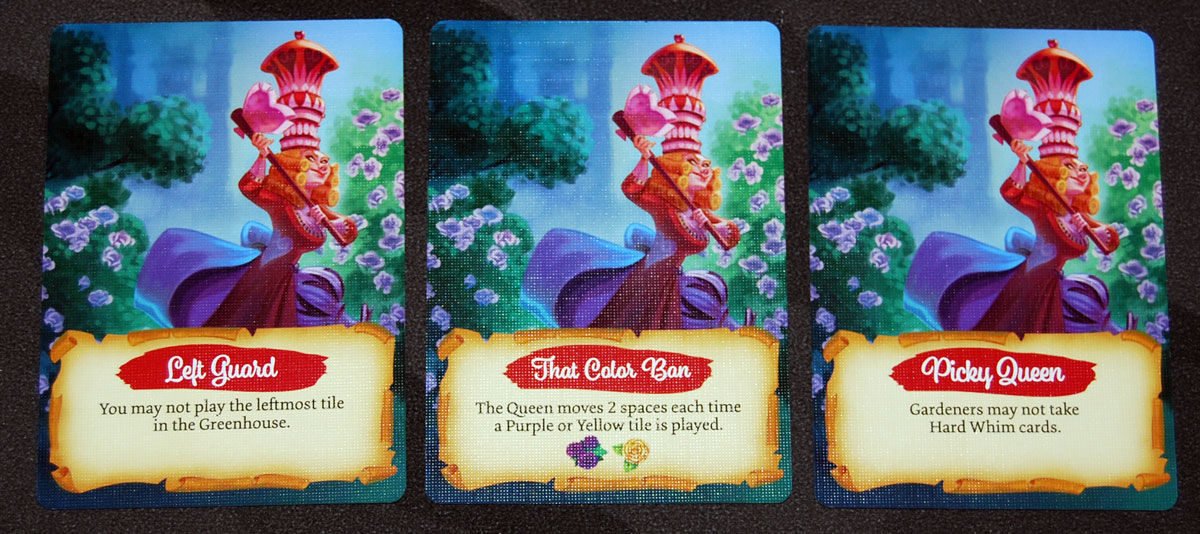
The Queen cards make things more difficult, restricting what you can do or moving the Queen forward to put more pressure on you.
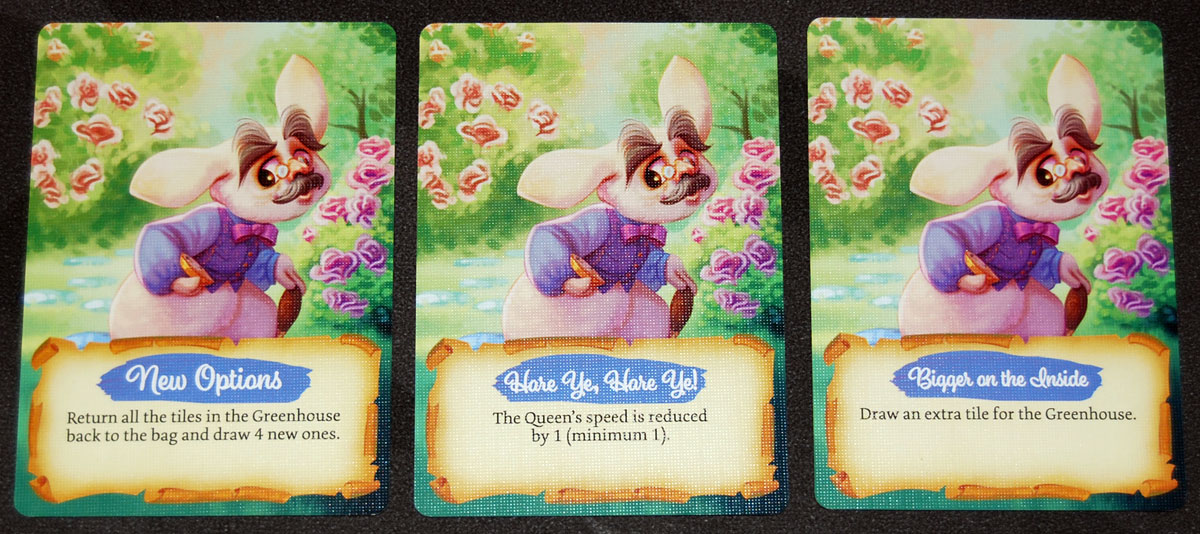
The Helper cards give you new effects that can be used once per turn.
Each Helper has its own rules about how to collect the keys and its set of actions and rules. For instance, the Cheshire Cat requires you to set up rows of 4 of the same color or suit, and has abilities to move shrub tiles around. Tweedledee and Tweedledum require you to guess two whim cards in the same turn. The White Rabbit is a speed run—the number of keys you get depends on how quickly you can fill the garden.
Why You Should Play Paint the Roses
I really love deduction puzzles, pruning away possibilities until all that’s left is the topiary that was hidden inside the shrub all along. It’s what draws me to hidden movement games and mystery-solving games and even games like The Crew, a trick-taking game in which you need to be able to figure out what cards your teammates have based on what they’ve played. Piecing together what somebody is trying to tell you based on some limited communication can be difficult—I mean, they’re specifically designed to be, of course—but it’s satisfying when it works.
The puzzles in Paint the Roses are fairly simple: it’s a pairing, either of two colors, two shapes, or a shape and a color, and your goal is to suss out the answer with some trial and error. It can feel a bit like playing 20 Questions: Is your clue “yellow to yellow”? What about “spade to heart”? You’re looking for the perfect place to put a tile so that your teammates can figure out your card with 100% certainty, but quite often that won’t be the case. Sure, this spot has two purples adjacent to it, but it also has two hearts. Okay, so that gives your teammates a 50-50 chance, which is not terrible. Sometimes you don’t have any great options for your own card, but you could place a tile to hone in on somebody else’s card.
As you get more experienced at the game (and more familiar with how your teammates think), you can move beyond just what’s been played and start making some inferences based on what wasn’t played. Aha! This other space would have been better for a spade-to-diamond match, so we could probably eliminate that. Hmm, we weren’t sure if purple was involved, but they didn’t play the purple shrub in the greenhouse, so that’s probably not it. While placing zero cubes may seem at first like it’s no information, it’s actually possible to say quite a lot while saying nothing.

There’s something a little weird to me about the way the game’s objective is explained, particularly in light of the score log. The rules describe the game as a win/lose situation: either you fill the garden successfully, or you get caught by the Queen and lose. But the scoring tells a different story: sure, getting your head chopped off isn’t great, but losing 10 points isn’t the end of the world, either. In fact, there instances where we had a higher score in a “losing” game than a “winning” game.
I asked the designer, Ben Goldman, about this phenomenon, and he said that he likes “score chasing.” For cooperative games, he’s all about trying to beat a high score, trying to do better than last time, and for that a simple win/loss status isn’t quite sufficient. It sounds like Goldman really prefers to think of the objective as “maximize your score” rather than “survive the Queen,” which does give a different framing for the game. Sure, not getting caught is worth 10 points, but it also makes the harder cards worth doing.
When I first played, I figured the hard cards were trickier to solve (there are more possible options), but that maybe there was a corresponding bigger reward. While it’s true that they’re worth more points, the rewards aren’t that much bigger, and the risks are significantly higher. You must make a guess every turn, ready or not, and if you’re wrong, the Queen moves double. With hard cards, it will typically take you 2 or 3 turns at least to get enough info to make a definitive guess—which means the Queen may have been gaining on you. When you do guess a hard card, the points you’re getting aren’t necessarily making up for that extra Queen movement—but it also means it takes fewer cards before you reach the White Rabbit and speed up the Queen even more.
As it turns out, the hard cards will lead to higher scores, but it’s also just a harder difficulty level for the game: it’s more likely that the Queen will catch you. Goldman’s explanation is that he thinks it’s more impressive to score higher, even if you get caught, than to win on an easier setting, and the scoring is how to rate your relative performances. Personally, I think the messaging is a little mixed between the victory condition and the score, but it’s up to your gaming group which way you want to play. I do think the hard cards are a more fun puzzle to tackle, but we haven’t survived doing too many of them.
Unfortunately, just with my current gaming circumstances, I haven’t gotten to try the expansion materials yet. They were only available in the physical prototype but not in Tabletop Simulator, and I was only able to play the physical prototype with my kids (one of whom is still a bit young for the game), so we weren’t ready to throw in more extras. I did play Paint the Roses with some adult friends on Tabletop Simulator, but then didn’t have access to the expansion there. I do think it would add some fun tweaks to the game: for instance, one of the things we often wished we could do was refresh the tiles in the greenhouse, and at least one of the Helpers has abilities that let you manipulate the greenhouse on your turn. It comes at the cost of dealing with the Queen cards, too, but I’m interested in seeing how that trade-off plays out.
Deduction games aren’t for everyone: despite the constant threat of beheading, solving logic puzzles may not feel very exciting. It’s not quite as intense as the cat-and-mouse chases in hidden movement games, especially when you realize that your head is only worth 10 points. But I like puzzles of all sorts and I’m a fan of the Wonderland theme, so Paint the Roses is an easier sell to me. I think the game needs a bit more spice than just the easy and medium cards, so I recommend mixing in hard cards once you’re familiar with the rules. The easy and medium cards are a good way to get started (and you’ll probably need to use some even when you introduce hard cards), and I’ll be mostly sticking to those when playing with my kids, too. I do like the fact that I can get my kids thinking about how to work out the puzzles in this game, and they’ve enjoyed playing it as well. I look forward to trying more games with the hard cards, and adding in the expansion as well.
For more information or to make a pledge, visit the Paint the Roses Kickstarter page!
Click here to see all our tabletop game reviews.
![]() To subscribe to GeekDad’s tabletop gaming coverage, please copy this link and add it to your RSS reader.
To subscribe to GeekDad’s tabletop gaming coverage, please copy this link and add it to your RSS reader.
Disclosure: GeekDad received a copy of this game for review purposes.





